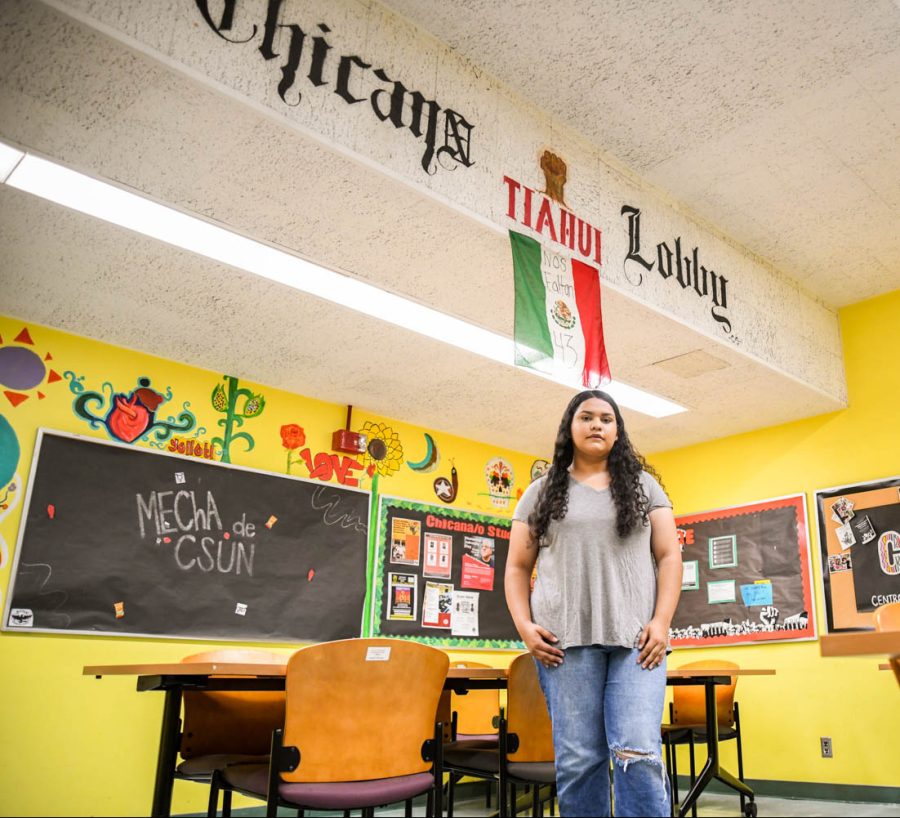CSUN’s Hispanic Heritage Month celebrations leave some wanting more
Crystal Esquivel in the Chicano Lobby in Jerome Richfield Hall at CSUN on Sept. 20, 2022, in Northridge, Calif.
November 17, 2022
Sept. 15 marked the beginning of National Hispanic Heritage Month, a time meant to celebrate the history and culture of the Hispanic American community. A community that, as of 2020, made up 18.7% of the population in the United States, according to the U.S. Census Bureau.
According to senior broadcast journalism major Melanie Guerrero, many people don’t even know it’s happening.
“I will be honest, I didn’t know Hispanic Heritage Month was a thing when I was a kid, just because it really wasn’t publicized in schools very often,” said Guerrero. “I only ever heard about Black History Month, which is great, but I honestly have never heard of it until literally the last few years.”
National Hispanic Heritage MonthNational Hispanic Heritage Month is not a new celebration. In fact, it was first introduced in June of 1968 by Rep. George E. Brown of California as a commemorative week, according to the Office of the Historian and the Clerk of the House’s Office of Art and Archives.
In September of the same year, President Lyndon Johnson issued the first National Hispanic Heritage Week presidential proclamation. Rep. Esteban Torres of California submitted a bill in 1987 to expand National Hispanic Heritage Week into National Hispanic Heritage Month.
Torres remarked that an extension of the celebrations would “allow our Nation to properly observe and coordinate events and activities to celebrate Hispanic culture and achievement,” and that those who supported the bill “want the American people to learn of our heritage. We want the public to know that we share a legacy with the rest of the country, a legacy that includes artists, writers, Olympic champions, and leaders in business, government, cinema, and science.”
Although the bill did not pass, Sen. Paul Simon submitted a similar bill that did pass Congress. So in 1988, President Ronald Reagan signed into law that the commemorative week be expanded into a month, starting Sept. 15 to Oct. 15, according to the government’s National Hispanic Heritage Month website.
Guerrero also didn’t know why National Hispanic Heritage Month started in the middle of the month, and was bothered by it.
“I didn’t realize that it was half of one month and half of another month. I just found that out recently. And that kind of threw me through a loop because I was like, ‘Um, excuse me. Why is that?’ That’s like saying we only deserve half the attention,” Guerrero said.
The dates are significant to many since Sept. 15 is the day Latin American countries Costa Rica, El Salvador, Guatemala, Honduras and Nicaragua declared their independence from colonial countries like Spain, according to the NHHM website. Mexico and Chile celebrate their independence on Sept. 16 and Sept. 18, respectively, while Dia de la Raza, Oct. 12, also falls within this 30-day period.
Melisa Galvan, an associate professor in the CSUN Department of Chicana and Chicano Studies, had a few critiques on how National Hispanic Heritage Month is handled in terms of celebrations.
“I would love to see it celebrated in general here. I haven’t seen much going on. It would be wonderful to involve the departments. Bring students together to create a space of cultural belonging for all of the students that identify and also the ones that don’t, just to educate them. Because not everyone’s going to take an ethnic studies course, not everyone’s going to understand why it’s important to know this and know the history of our nation in that light. So events, in general, are just really important,” Galvan said.
Galvan also pointed out that CSUN is a Hispanic-serving institution, and believes that it is the school’s duty to embrace the culture and community of all students, especially during this type of month.
“We did a lot for African American History Month. I mean, last year, I remember during the pandemic, there was a lot of programming,” said Galvan. “But for some reason, there’s radio silence on this one. And I wonder if we’re taken for granted. I think it’s something that we need to sort of reflect on as a campus community, how we can do a little bit better with that.”
